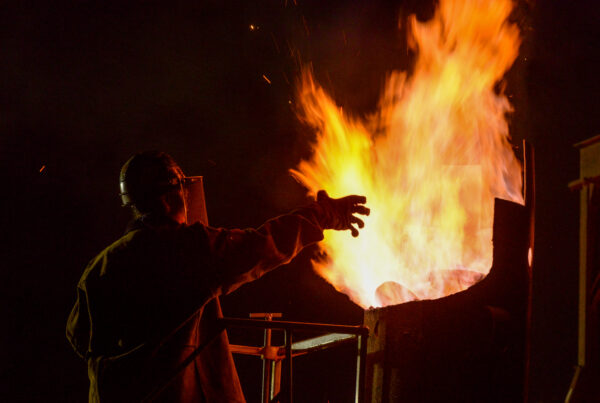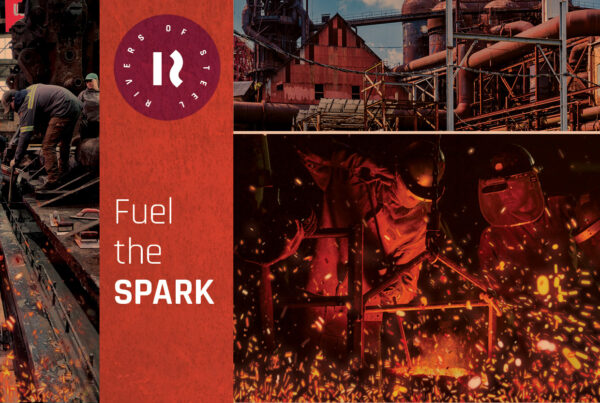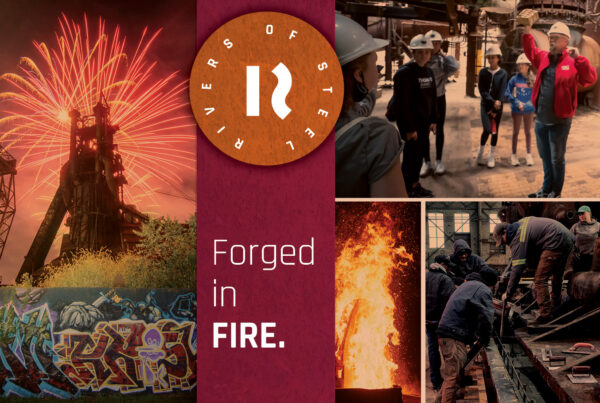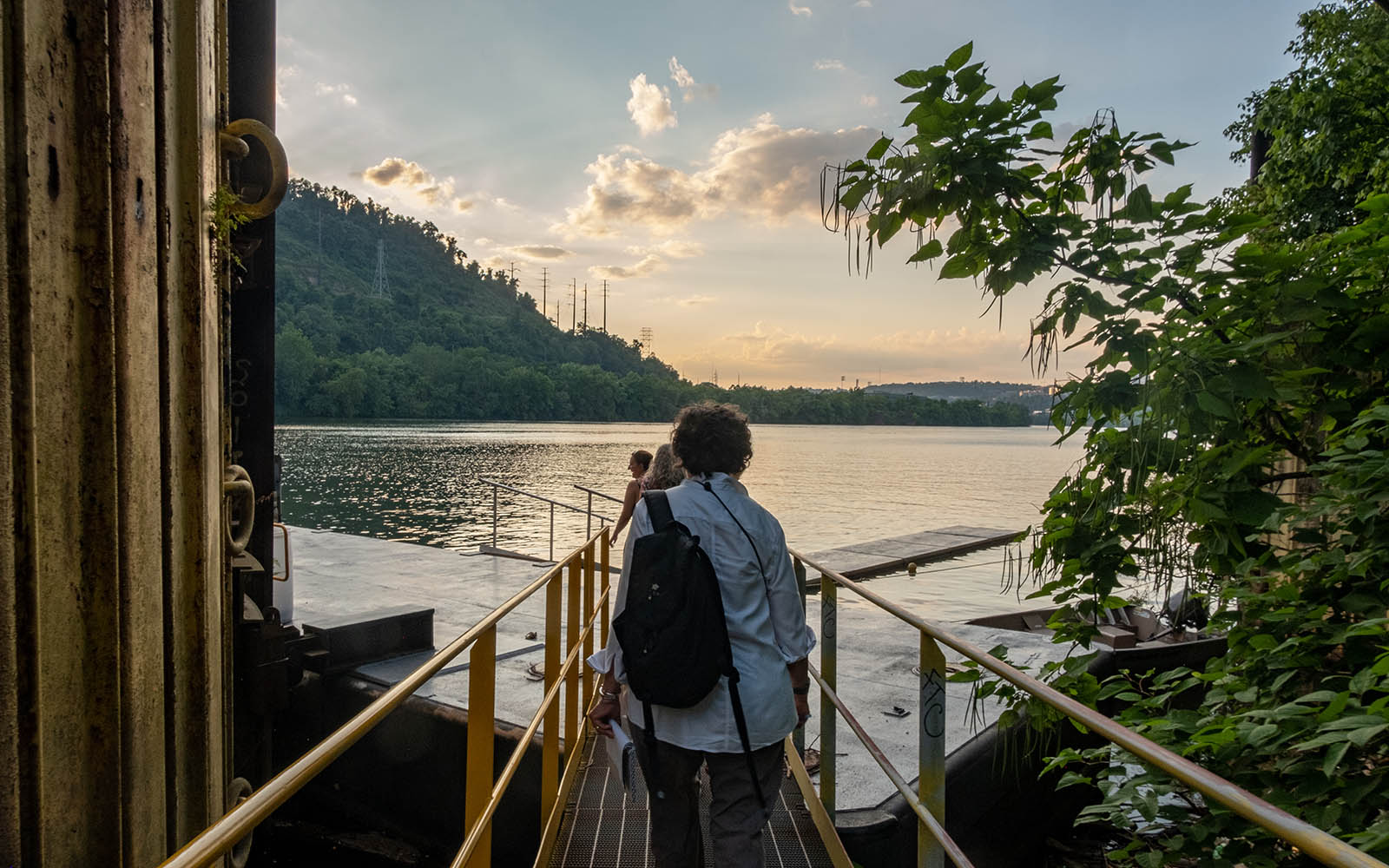
Shiftworks’ Write the Rivers workshop with Sherrie Flick explored new ways of including the public in public art. Photo by Heather Mull.
Getting to Know: Shiftworks
The Getting to Know series helps you become better acquainted with some of Rivers of Steel’s partners throughout the eight-county Rivers of Steel National Heritage Area by featuring one of our community allies. For part two of the Shiftworks series, writer Jason Vrabel examines how Shiftworks Community + Public Arts serves its mission by creating opportunities for the public to engage in creating public art.
By Jason Vrabel, on behalf of Shiftworks
Expanding the Boundaries of Public Art
More than a dozen people fanned out across the Allegheny River shoreline in search of found objects—or in this case, more commonly known as trash. This area north of Pittsburgh is marsh-like near the delta of Plum Creek, but lush and forested farther inland. Aside from two fishermen, everyone there on a Saturday morning in June arrived by kayak, a 15-minute paddle from the 10.7 Marina in Verona.
They were there to create art with Monica Cervone McElwain, one of several artists commissioned by Shiftworks Community + Public Arts to design public art tours. Taking place between summer and fall, this program includes two different kayak journeys and multiple walking tours. Combined, the events share a common goal of educating people about what public art is, what it can be, and engaging them in the process of creating it.

A group of kayakers paddle towards the confluence of Plum Creek at Allegheny River in Oakmont. Photo by Ishara Henry.
Once everyone was on land, McElwain’s instructions to the group were intentionally vague: Go explore, and bring back anything you can reuse creatively
“This is a little bit of a choose your own adventure,” McElwain said. As a multimedia artist and art teacher, McElwain says the purpose of these events, now in their second year, is to create opportunities for art making, but also for adults to play.
As a regular visitor to this area, McElwain knows that her groups will mostly find bona fide trash—a lot of pop bottles and beer cans—but more interesting objects usually turn up, like decorative metal pieces of a stair railing, or a yo-yo. “I once found a beautifully preserved deer head . . . and, of course, I made something out of it,” she said.
The returning participants amassed a pile of human-made objects, like a rubber wheel and some river glass, as well as more natural discoveries like feathers and branches. One participant stayed out on the water and finally returned with two large sheets of crumpled metal, weathered by water and sun. To help with assembly, McElwain brought along fishing line, wire, and other art supplies.
Turtle Cove is only a few miles from the city border but feels much farther. Serene and pastoral, evidence of the built environment is scarce—except, that is, for River’s Edge, a new housing development on the other side of Plum Creek.
Most of the participants gravitated toward a sculpture McElwain had started previously, partially constructed with white PVC pipe. McElwain didn’t know for sure where the pipe came from but said it was “probably something that came from all that building across the creek.”
McElwain says trash is always present, but the inlet isn’t overrun with it. Even though cleaning up Turtle Cove is part of every trip she takes there (she hauls away as much as she can that is not “creatively exciting”), she isn’t heavy-handed about the environmental message. Instead, she wants her groups to pay attention to the natural environment and use it in their creative process.
“Seeing and hearing birds, and being in the sun with the wind hitting you helps pull in that natural environment when you’re creating,” McElwain said.
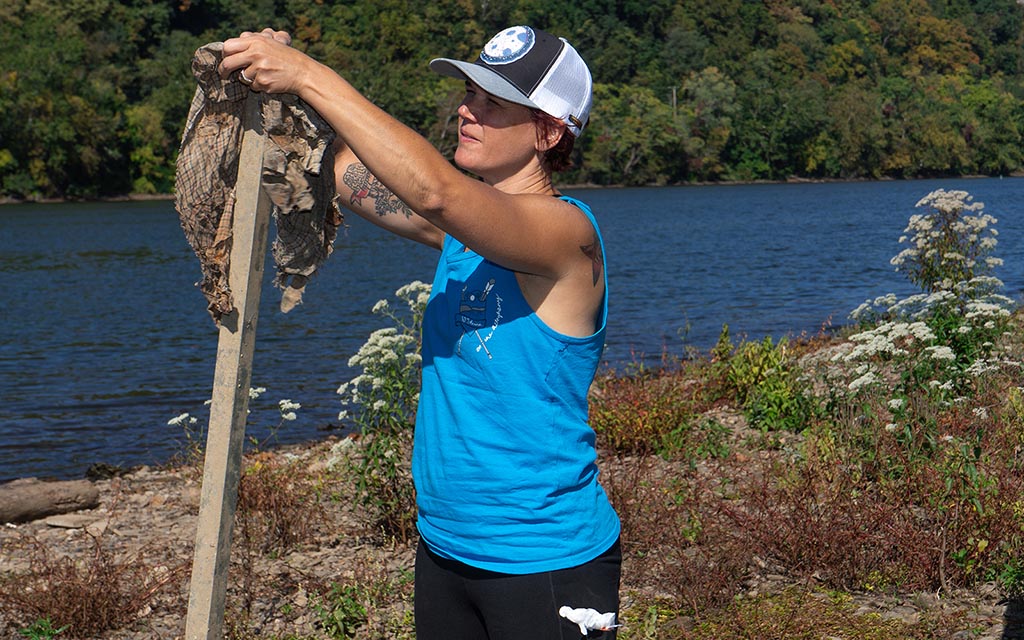
Monica Cervone McElwain creates an assemblage with found objects. Photo by Ishara Henry.
An Evolving Process
Previously known as the Office for Public Art, Shiftworks can be found where art intersects with civic design in the Pittsburgh region. The organization’s mission to catalyze change through civically engaged, artist-led projects in public spaces took on greater urgency during the pandemic. As social isolation was taking root, Shiftworks partnered with Riverlife (an organization whose mission is to activate Pittsburgh’s riverfronts) to encourage safe social gathering outdoors. The immediate result was a series of commissioned public art projects along the Allegheny River and Allegheny Landing.
This led to the formation of the Pittsburgh Creative Corps, a pool of local artists who can be called upon whenever new public art opportunities arise. More than 100 artists are now part of the Corps, some of whom have been invited by Shiftworks and its partners to propose and create their own projects.
Rachel Klipa, Shiftworks’ program manager for education, says these tours are educational and less intensive than many of the organization’s other programs, which often involve multiyear commitments between artists and the communities in which they work. These summer events are intended to engage artists who can create new opportunities for the public to participate in the making of art without a lot of constraints.
“We want to let people determine their own experience,” Klipa said. “We want to let them see what they want and create what they want.”
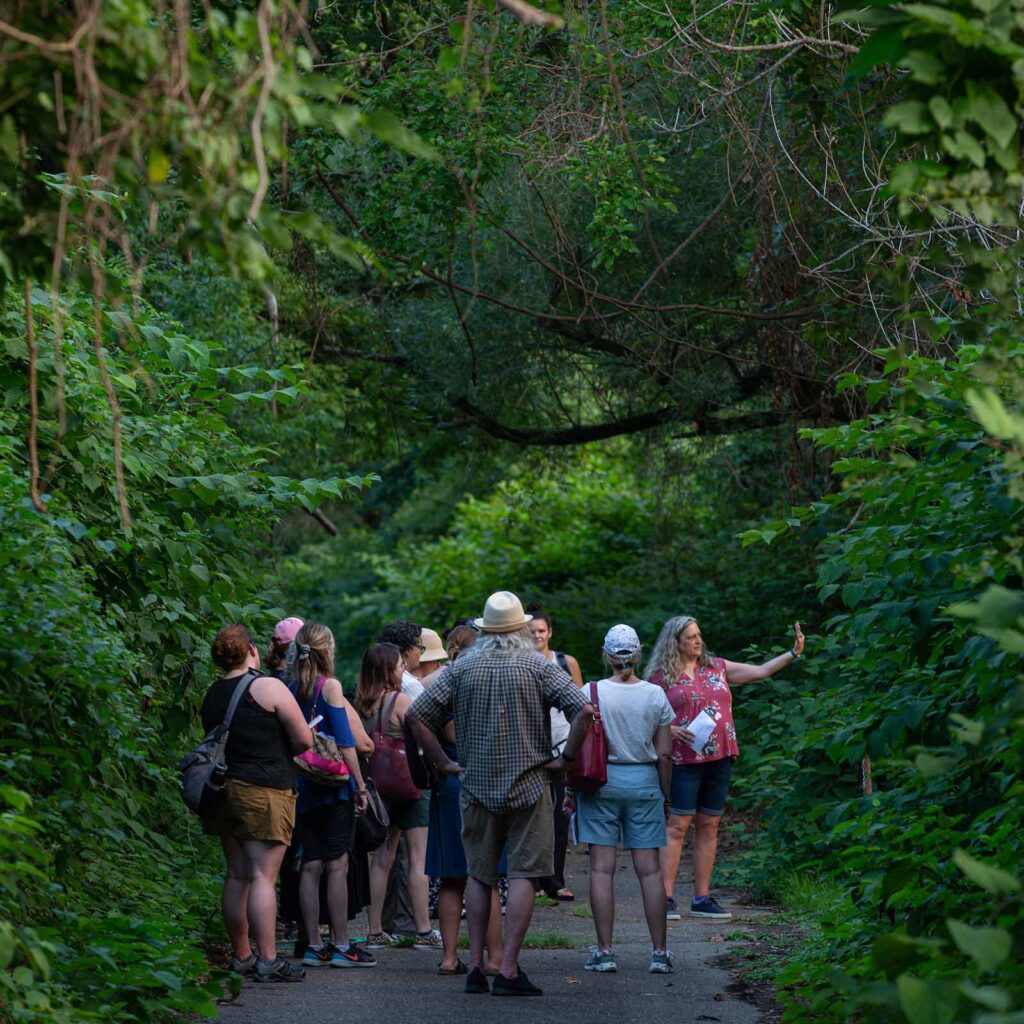
A Walk & Write with Sherrie Flick, (far right)/ Photo by Heather Mull Photography.
Walk & Write
Sherrie Flick is another member of the Corps who also curates experiential art events for Shiftworks. Her tours are by foot—mostly through parks and neighborhoods—and focus on the art of writing. Flick sometimes leads the tours herself but often collaborates with other writers of fiction, nonfiction, and poetry.
As an instructor at Chatham University and an accomplished author (with a novel and several short-story collections to her name), Flick designed the Walk & Write tours to spark creativity through movement and observation. Whether touring the built environment of downtown Pittsburgh or the natural landscape of Frick Park, participants are provided with writing prompts along the way. Tour guides may relay their own personal histories with the site or read from their own work to inspire writing within the group.
This summer, while exploring the physical space between the Ohio River and the shuttered Western Penitentiary, Flick’s co-host Sarah Shotland led participants along a trail adjacent to the neighborhoods of Manchester and Marshall-Shadeland. Officially known as State Correctional Institution—Pittsburgh, the penitentiary’s future has been a recent topic of debate. Those who see its historic architectural value want to preserve and reuse the structure, but others want to demolish a menacing symbol of incarceration and reuse only the land.
As an author who once taught writing to inmates inside Western Penitentiary, Shotland prompted participants to think about space—inside and outside. By juxtaposing the massive structure with the Ohio River just beyond the prison walls, tour participants moved through the space in between, while being prompted to consider the tension between confinement and freedom.
Many of us know how a short walk can help clear our minds. Beyond the scientific evidence that indicates we think differently when we are moving, Flick says we become better observers of our surroundings when we are passing through them. Flick teaches that good writing comes from keen observation, so to improve our writing, we must first improve our observing.
“Observation connects us to setting, which connects us to objects, which connects us to characters, and so on,” Flick said, noting that good observation skills are important to writers of any genre. Furthermore, “writing from a place of observation helps us write without judgment”—something that experienced and novice writers alike can learn over time.
“The main idea is you’re reacting to the observed world,” Flick said. By guiding people through a familiar place in a creative way, their perception of that place can change.
Walk & Write tours are designed for all kinds of writers at any level of ability, including those who don’t think of themselves as writers at all. Participants who have chosen to share their writing with their groups have written some great things, Flick says, but merely sharing observations about the places they visit can be just as valuable.
What is public art? How is it made, and by whom?
It’s generally understood that art, in a broad sense, includes music, dance, and other forms of creative expression, but people often associate public art with static objects such as sculptures and murals. While traditional forms of public art make valuable contributions to the public realm, broadening our collective understanding of what public art can be is part of Shiftworks’ mission.
“Public art is art that exists in the public realm, however briefly,” Klipa said. “Sometimes it may only be experienced by whoever is present at a particular place and moment in time.”
Shiftworks’ civically engaged art programs have supported artists whose work expands the boundaries of public art, often through ephemeral and experiential elements. Social gatherings, yoga sessions, theatrical performances, sewing, and cooking have all been foundational to Shiftworks-supported projects throughout the years. Because that kind of work requires deep community engagement and extensive training, and provides opportunities to only a limited number of artists, Klipa wanted the summer series to present opportunities for new audiences and artists to work in the public realm on a short-term basis.
“Public art doesn’t have to be an object,” Flick said. “The art ends up being all the written pieces the participants have drafted. I’m the conduit. They’re creating these little pieces that they can carry on and continue with.”
While the works of art made during McElwain’s kayak tours are objects, they’re ephemeral ones. The artists can no longer see their work after they’ve left the island, and because the inlet occasionally floods, the work will be washed away eventually.
In addition to creating more opportunities for the public to make art, Shiftworks has been equally committed to the ongoing development of the artists, by moving away from traditional public art walking tours to commissioning artists to design experiences in the public realm. To promote more artist-designed projects, Klipa says that Pittsburgh Creative Corps artists (even those with little to significant public engagement experience) are candidates for future tour commissions.
McElwain’s project was born from her own family kayak trips to Turtle Cove. (“Turtle Cove” isn’t an official place, but a made-up name given by an acquaintance of McElwain.) She had recently painted a mural at the 10.7 Marina when she got the idea to take the traditional art walking tour concept out into the rivers. Walk & Write’s origin was similar. Flick had been involved with Shiftworks tours of public art and architecture downtown since 2017; they were educational, but the overall experience was limited to discussions about existing art created by someone else.
Since then, Flick has allowed the Walk & Write tours to evolve into the participatory form they take today, and she appreciates the freedom she has to design or modify each one. “They’re different every time and not done by rote,” she said.
Sometimes they’re different in unexpected ways. Last year, a tour in Frick Park that didn’t account for early nightfall nearly had to be rescheduled until Flick proposed going forward in the dark—with headlamps. Klipa said this was a “great solution” and an example of both Shiftworks’ flexibility and the artist’s ability to adapt. Flick said the “night hike” was such a great experience, that this year’s park tour in September will not begin until dark.
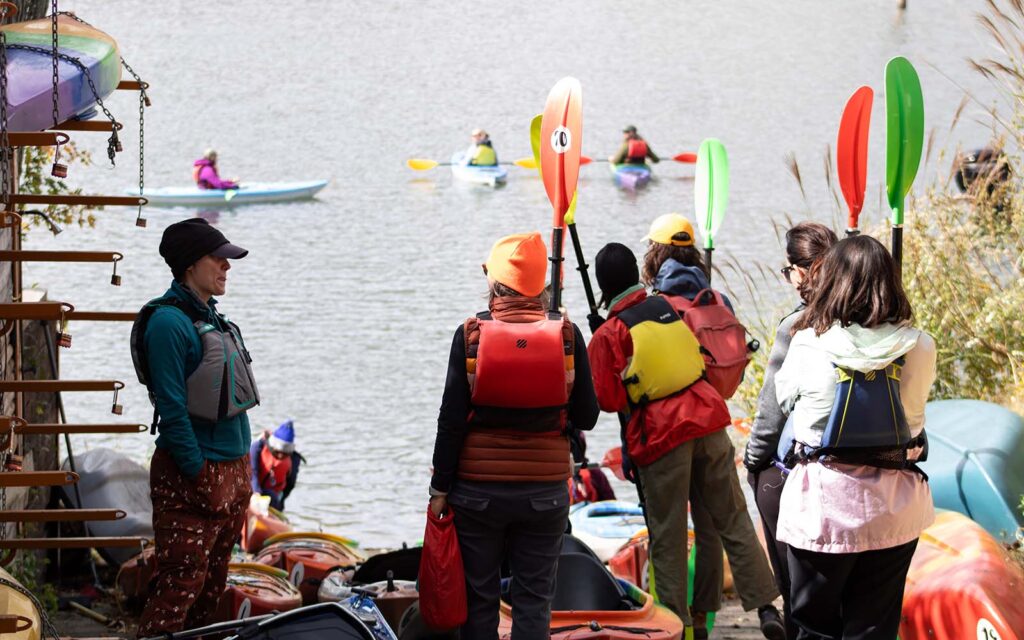
Erin Mallea’s Sycamore Island tour. Photo by Ishara Henry.
No Beginning or End
The summer public art series embodies Shiftworks’ goal of helping our region understand the value of public art and the unique contributions of artists who work in the public realm. For McElwain, tours to Turtle Cove don’t really have a beginning or end, and the artwork her groups create will likely change by the time she returns. Because it’s not uncommon for visitors to alter the art, her next group will inherit whatever is there.
Already thinking ahead to next year, McElwain is considering ways to engage with other visitors—possibly through signage, notebooks, or QR codes—but doesn’t want to dictate what others do with whatever they find there.
“You may not understand it, but just be respectful” is the message she wants to convey to those who happen upon the artwork. After all, McElwain remarked with a laugh, she doesn’t interfere with fire pits left behind by “the kids who make their bonfires.” But she does recycle their beer cans.
Beyond whoever commissions or creates it, the most intriguing aspect of public art is who it belongs to.
Getting Involved
This year, Shiftworks’ public art events will continue through October. Artist Erin Mallea will lead two more kayak tours—to Sycamore Island, one of the few currently undeveloped islands in Allegheny County. There will also be three more Walk & Write events. A writing tour led by Nancy Krygowski will take place in Greenfield, and Flick will lead the September “night hike” in Schenley Park. Flick has also collaborated with local archivist and historian Jennie Benford to design a Walk & Write tour of Homewood Cemetery, which will occur later in October. An event schedule and registration information can be found here.
Derek Reese, Shiftworks’ manager of artist services, holds open office hours twice a week. Artists interested in working in the public realm can schedule in-person or virtual appointments through Shiftworks’ events page.
About Shiftworks
Shiftworks Community + Public Arts envisions a region in which the creative practices of artists are fully engaged to collaboratively shape the public realm and catalyze community-led change. Shiftworks builds capacity for this work through civically engaged public art, artist resources, public programming, and technical assistance.
If you’d like to learn more about Shiftworks, read about their working relationship with communities in creating public art in part one of the Getting to Know: Shiftworks series.

